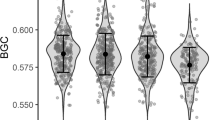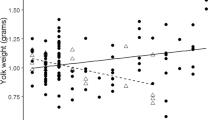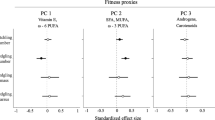Abstract
The deposition of androgens into the yolks of eggs can have long-lasting effects on the growth and development of young birds. It has been proposed that female birds and reptiles deposit yolk androgens according to the differential allocation hypothesis (DAH), which posits the allocation of more resources to offspring sired by more attractive, higher-quality males. We examined deposition patterns of yolk androgens in relation to mate attractiveness in the house finch Carpodacus mexicanus. Contrary to the predictions of the DAH, female house finches deposited significantly more androgens into eggs sired by less attractive males. We propose that, rather than serving as resources, androgens are used as mediators in a compensatory distribution strategy, enabling females to improve the quality of young produced with less attractive males.




Similar content being viewed by others
References
Badyaev AL, Hill GE (2002) Paternal care as a conditional strategy: distinct reproductive tactics associated with elaboration of plumage ornamentation in the house finch. Behav Ecol 13:591–597
Badyaev AL, Hill GE, Beck ML (2003) Interaction between maternal effects: onset of incubation and offspring sex in two populations of a passerine bird. Oecologia 135:386–390
Burley N (1988) The differential-allocation hypothesis: an experimental test. Am Nat 132:611–628
Dervan A (2001) The effects of hatch order and sex on nestling growth in the house finch. Department of Biological Sciences. Auburn University, Auburn, AL
Dierenfeld E, Norkus E, Carroll K, Ferguson G (2002) Carotenoids, vitamin A, and vitamin E concentrations during egg development in panther chameleons (Furcifer pardalis). Zoo Biol 21:295–303
Eising C, Groothuis TGG (2003) Yolk androgens and begging behaviour in black-headed gull chicks: an experimental field study. Anim Behav 66:1027–1064
Elf PK, Fivizzani AJ (2002) Changes in sex steroid levels in the yolks of the leghorn chicken, Gallus domesticus, during embryonic development. J Exp Zool 293:594–600
French JB Jr, Nisbet ICT, Schwabl H (2001) Maternal steroids and contaminants in common tern eggs: a mechanism of endocrine disruption? Comp Biochem Physiol 128:91–98
Gil D, Graves J, Hazon N, Wells A (1999) Male attractiveness and differential testosterone investment in zebra finch eggs. Science 286:126–128
Gil D, Leboucher G, Lacroix A, Cue R, Kreutzer M (2004) Female canaries produce eggs with greater amounts of testosterone when exposed to attractive male song. Horm Behav 45:64–70
Green AJ (2001) Mass/length residuals: measures of body condition or generators of spurious results? Ecology 82:1473–1483
Groothuis TG, Eising C, Dijkstra C, Müller W (2005) Balancing between costs and benefits of maternal hormone deposition in avian eggs. Biol Lett 1:78–81
Groothuis TG, Schwabl H (2002) Determinants of within- and among-clutch variation in levels of maternal hormones in black-headed gull eggs. Funct Ecol 16:281–289
Hill GE (1990) Female house finches prefer colourful males: sexual selection for a condition-dependent trait. Anim Behav 40:563–572
Hill GE (1991) Plumage coloration is a sexually selected indicator of male quality. Nature 350:337–339
Hill GE (1993) Male mate choice and the evolution of female plumage coloration in the house finch. Evolution 47:1515–1525
Hill GE (1993) Male mate choice and the evolution of female plumage coloration in the house finch. Can J Zool 71:619–627
Hill GE (1998) An easy, inexpensive method to quantify plumage coloration. J Field Ornithol 69:353–363
Hill GE (2002) A red bird in a brown bag. Oxford Univ. Press, New York
Hill GE, Farmer KL (2005) Carotenoid-based plumage coloration predicts resistance to a novel parasite in the house finch. Naturwissenschaften 92:30–34
Hill GE, Montgomerie R, Roeder C, Boag P (1994) Sexual selection and cuckoldry in a monogamous songbird: implications for theories of sexual selection. Behav Ecol Sociobiol 35:193–200
Klukowski LA, Cawthorn JM, Ketterson ED, Nolan V Jr (1997) Effects of experimental elevated testosterone on plasma corticosterone and corticosteroid-binding globulin in dark-eyed juncos (Junco hyemalis). Gen Comp Endocrinol 108:141–151
Lipar JL, Ketterson ED (2000) Maternally derived yolk testosterone enhances the development of the hatching muscle in red-winged blackbird Agelaius phoeniceus. Proc R Soc Lond Ser B 267:2005–2010
Lipar JL, Ketterson ED, Nolan V Jr (1995) Steroid hormones in the yolk of red-winged blackbird eggs. Poult Avian Biol Rev 6:329
Lovern MB, Wade J (2001) Maternal plasma and egg yolk testosterone concentrations during embryonic development in green anoles (Anolis carolinensis). Gen Comp Endocrinol 124:226–235
McGraw KJ, Stoehr AM, Nolan PM, Hill GE (2001) Plumage redness predicts breeding onset and reproductive success in the house finch: a validation of Darwin’s theory. J Avian Biol 32:90–94
Mendonça MT, Chernetsky SD, Nester KE, Gardner GL (1996) Effects on gonadal sex steroids on sexual behavior in the big brown bat Eptesicus fuscus, upon arousal from hibernation. Horm Behav 30:153–161
Michl G, Török J, Péczely P, Garamszegi LZ, Schwabl H (2005) Female collared flycatchers adjust yolk testosterone to male age, but not to attractiveness. Behav Ecol 16:383–388
Navara KJ, Hill GE, Mendonça MT (2005) Variable effects of yolk androgens on growth, survival, and immunity in eastern bluebird nestlings. Physiol Biochem Zool 78:570–578
Olsen NJ, Kovacs WJ (1996) Gonadal steroids and immunity. Endocr Rev 17:369–384
Pilz KM, Smith HG, Sandell MI (2003) Interfemale variation in egg yolk androgen allocation in the European starling: do high-quality females invest more? Anim Behav 65:841–850
Pilz KM, Smith HG, Sandell MI, Schwabl H (2003) Inter-female variation in egg yolk androgen allocation in the European starling: do high quality females invest more? Anim Behav 65:841–850
Pilz KM, Quiroga M, Schwabl H, Adkins-Regan E (2004) European starling chicks benefit from high yolk testosterone levels during a drought year. Horm Behav 46:179–192
Reist JD (1985) An empirical evaluation of several univariate methods that adjust for size variation in morphometric data. Can J Zool 63:1429–1439
Royle NJ, Surai PF, Hartley IR (2001) Maternally derived androgens and antioxidants in bird eggs: complimentary but opposing effects? Behav Ecol 12:381–385
Rutstein AN, Gilbert L, Slater PJB, Graves JA (2005) Sex-specific patterns of yolk androgen allocation depend on maternal diet in the zebra finch. Behav Ecol 16:62–69
Saino N, Romano M, Ferrari R, Martinelli R, Møller AP (2003) Maternal antibodies but not carotenoids in barn swallow eggs covary with embryo sex. J Evol Biol 16:516
Schwabl H (1993) Yolk is a source of maternal testosterone for develo** birds. Proc Natl Acad Sci U S A 90:11446–11450
Schwabl H (1996) Environment modifies the testosterone levels of a female bird and its eggs. J Exp Zool 276:157–163
Schwabl H (1996) Maternal testosterone in the avian egg enhances postnatal growth. Comp Biochem Physiol A 114:271–276
Schwabl H (1997) The contents of maternal testosterone in the house sparrow Passer dimesticus eggs vary with breeding conditions. Naturwissenschaften 1984:1–3
Sheldon BC (2000) Differential allocation: tests, mechanisms and implications. Trends Ecol Evol 15:397–402
Sockman KW, Schwabl H (2000) Yolk androgens reduce offspring survival. Proc R Soc Lond Ser B 267:1451–1456
Sockman KW, Schwabl H, Sharp PJ (2001) Regulation of yolk-androgen concentrations by plasma prolactin in the American kestrel. Horm Behav 40:462–471
Sokal R, Rohlf J (1995) Biometry, 3rd edn. Freeman, New York, NY
Surai PF, Speake BK, Wood NAR, Blount JD, Bortolotti GR, Sparks NHC (2001) Carotenoid discrimination by the avian embryo: a lesson from wild birds. Comp Biochem Physiol B 128(4):743–750
Tanvez A, Béguin N, Chastel O, Lacroix A, Leboucher G (2004) Sexually attractive phrases increase yolk androgens deposition in canaries (Serinus canaria). Gen Comp Endocrinol 138:113–120
Whittingham L, Schwabl H (2001) Maternal testosterone in tree swallow eggs varies with female aggression. Anim Behav 62
Acknowledgements
We thank the members of the Mendonça and Hill laboratories for their comments and input on both the experimental design and the manuscript. This work was supported by the National Science Foundation grants DEB0075388, DEB0218313, and IBN0235778. Nestlings were handled under a State of Alabama permit (no. 12) and federal permit (no. 784373). The experiments described herein comply with the laws of the USA.
Author information
Authors and Affiliations
Corresponding author
Additional information
Communicated by J. Graves
Rights and permissions
About this article
Cite this article
Navara, K.J., Hill, G.E. & Mendonça, M.T. Yolk androgen deposition as a compensatory strategy. Behav Ecol Sociobiol 60, 392–398 (2006). https://doi.org/10.1007/s00265-006-0177-1
Received:
Revised:
Accepted:
Published:
Issue Date:
DOI: https://doi.org/10.1007/s00265-006-0177-1




